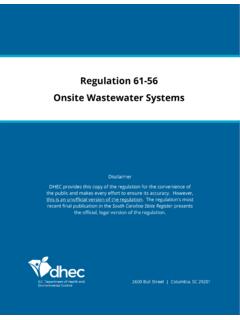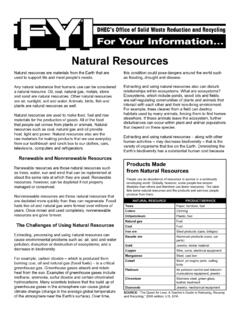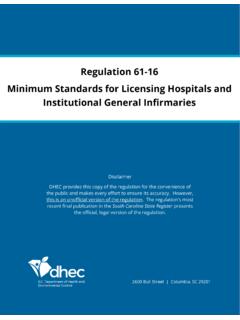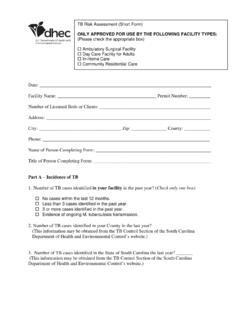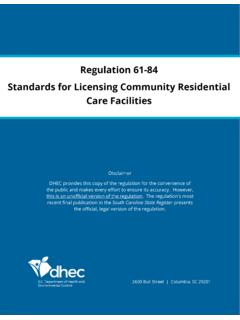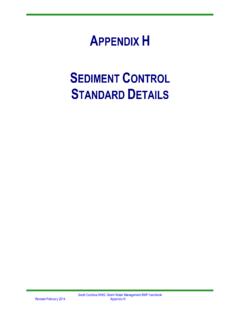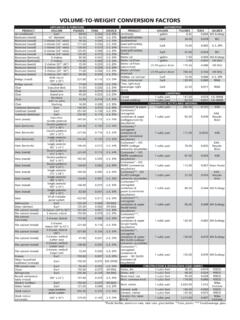Transcription of SC DHEC Stormwater BMP Handbook Sediment Basins
1 SC dhec Stormwater BMP Handbook Sediment Control BMPs Sediment Basins ` March 2014 Stormwater BMP Handbook South Carolina Department of Health and Environmental Control SB-1 Introduction Sediment Basins are a Best Management Practice (BMP) used to collect and impound Stormwater runoff from disturbed areas (typically 5 acres or more) at construction sites to restrict sediments and other pollutants from being discharged off-site. These Basins may also be used to control the volume and velocity of the runoff through a timed release by utilizing multiple spillways. It is through this attenuation of runoff that Sediment Basins may be capable of meeting South Carolina s Design Requirements, specifically the Total Suspended Solids (TSS) removal efficiency of 80%.
2 These Basins work most effectively in conjunction with additional Sediment and erosion control BMPs installed and maintained up gradient of the Basins . Guidance Disclaimer This is a guidance document and may not be feasible in all situations. Alternative means and methods for Sediment basin design and construction also may be employed. All means and methods must comply with the dhec South Carolina NPDES General Permit for Stormwater Discharges from Construction Activities (Permit). Approved means and methods include those published and approved by an MS4 in compliance with the Permit. In addition, a licensed Professional Engineer may design a Sediment basin that, when constructed, accommodates the anticipated Sediment loading from the land-disturbing activity and meets a removal efficiency of 80% suspended solids or ML/L peak settable solids concentration, whichever is less, while remaining in compliance with the Permit.
3 FEATURES Sediment Control Volume Control Velocity Control SECTIONS General Design Forebays Porous Baffles Basin Dewatering Skimmers Spillways Permanent Pools Maintenance Design Aids ALSO ADDRESSED Inlet Protection Basin Safety Sediment Storage Slope Stabilization Rock Berms Outlet Protection Basin Removal PLAN SYMBOL Sediment Basins SC dhec Stormwater BMP Handbook Sediment Control BMPs Sediment Basins ` March 2014 Stormwater BMP Handbook South Carolina Department of Health and Environmental Control SB-2 General Information Located near the site s perimeters, Sediment Basins can be created by the building of an embankment or through excavation, when the topography is relatively flat. Careful planning is necessary, during both design and construction phases, to ensure that Sediment Basins are not placed within Waters of the State (WoS) and are installed prior to the implementation of mass clearing, grubbing, and grading activities.
4 As runoff discharges into a Sediment basin, specific mechanisms are used to reduce the velocity and turbulence of the runoff to allow for settling of suspended particles, a process known as sedimentation. Examples of these mechanisms include Sediment forebays, porous baffles, and spillways with outlet structures that only discharge water from near the surface of the water column impounded within the basin. After construction of the basin, routine inspection and maintenance of Sediment Basins along with the implementation of additional Sediment and erosion control BMPs up gradient of the basin is essential to maintain the required trapping efficiency. Image Source: Alabama NRCS Design Requirements TSS Removal Efficiency* > 80% Peak Settleable Solids Conc.
5 * < mL/L Discharge Capacity 10-yr, 24-hr Storm Event Inspections and Maintenance** Weekly Internal Components** Sediment Forebay Basin Inlets Porous Baffles Between Inlets & Outlets Water Surface Dewatering Basin Outlets * Whichever is less. ** Maintenance as necessary per inspection. **Unless Infeasible. The above requirements shall serve as a baseline for all Sediment basin design within the state of South Carolina. For further reference see SC State Regulations Standards for Stormwater Management and Sediment Reduction (Section ) and the SC NPDES General Permit for Stormwater Discharges from Construction Activities SCR100000 (Section ). The following sections of this guidance can be used to aid in the design of a Sediment basin capable of meeting, if not exceeding, the above requirements.
6 The selection and implementation of these practices should be based on the best professional judgment and the conditions expected at the construction site during the lifespan of each Sediment basin. SC dhec Stormwater BMP Handbook Sediment Control BMPs Sediment Basins ` March 2014 Stormwater BMP Handbook South Carolina Department of Health and Environmental Control SB-3 Additional Design Considerations Drainage Area 5-30 Acres* Sediment Storage 3600 ft3/Acre Draining Min Dewatering Time 2 days (48 hours) Max Dewatering Time 5 days (120 hours) Basin Shape - L = 2W (Minimum) Cleanout Height - 1/2 Sediment Storage Forebay Volume 20% Sediment Storage Porous Baffles 3 Rows (Minimum) Basin Inlets Stabilized to Prevent Scour Basin's Bottom Slope or Steeper Embankments 2H:1V or Flatter *30 Acre Limitation Based off Design Aids Section.
7 Larger drainage areas may be acceptable when using an alternative methodology to calculated trapping efficiencies. Location The location of Sediment Basins at a construction site will vary due to site-specific conditions, but the following items should be used as guidance to determine the most appropriate location: Not within Waters of the State: It is prohibited to construct in or use Waters of the State as a Sediment basin. Down Gradient from Major Grading Activities: Locations down gradient of large scale grading operations will promote Sediment control during construction activities. Near Identified Outfalls: Locations near the determined site outfall will allow Sediment Basins to collect the majority of the runoff from the disturbed area. Multipurpose Use: Many construction sites will utilize a Sediment basin as a detention pond after construction activities are completed.
8 Selection of an area that allows for the installation of a Sediment basin that can be converted to a detention pond post-construction is recommended. Exclude Runoff from Off-Site and Undisturbed Areas: The placement of Sediment Basins are recommended at a location that restricts the amount of Stormwater runoff impounded from off-site and other undisturbed areas. Placement of temporary diversions berms, swales, or other conveyance measures may be required to divert the "clean" Stormwater runoff away from the basin. This practice will minimize the drainage area being served by the Sediment basin and may decrease the surface area required by the Sediment basin. Safety Incorporate all possible safety precautions, such as signs and fencing, for Sediment Basins that are readily accessible to populated areas.
9 For Example, a lateral shelf that is located above the Sediment cleanout elevation may prevent entry onto the accumulated Sediment and may also help with maintenance of the basin. In some circumstances, vector control may be necessary for Sediment Basins that routinely have a standing pool of water. This is especially important around residential areas to inhibit a rise in mosquito populations and the spread of disease. Maintaining a water depth of at least 3 feet within Basins with permanent pools may also help prevent a rise in mosquito populations. All other applicable safety criteria as outlined by the USDA Soil Conservation Service (previously the Natural Resources Conservation Service), the Army Corps of Engineers, and state Dam Safety Regulations should also be followed during design and construction of Sediment Basins .
10 SC dhec Stormwater BMP Handbook Sediment Control BMPs Sediment Basins ` March 2014 Stormwater BMP Handbook South Carolina Department of Health and Environmental Control SB-4 Basin Design Criteria Properly sizing a Sediment basin is crucial to improving Sediment control during construction conditions. When designing a basin the following criteria should be addressed: Storage Volume: The minimum Sediment storage volume recommended within a Sediment basin is equal to 3,600 cubic feet per acre draining to the basin. Twenty percent (20%) of this volume should be provided within the Sediment forebay. (Basin Volumes of 50 ac-ft or more may be subject to Dam Safety Regulations and Permits.) Shape: Sediment Basins should be designed to maximize the flow length between the Basins inlets and outlets.
